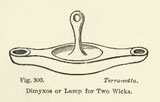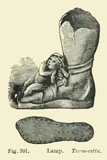Previous First Next
SALAMIS IN THE ISLAND OF CYPRUS.
BY ALEXANDER PALMA DI CESNOLÀ, F.S.A.,
page 124 CHAPTER XXII.
LAMPS.
 HE number of lamps recovered from Cypriote sites is very large indeed. Their variety is almost equal to their number, for very rarely are two found to correspond in every particular. According to the writer Clemens of Alexandria, the Egyptians1 claim the credit of the invention of lamps. And Herodotus not only speaks of the "Feast of Lamps" at Sais on the Nile, but also of the lamp which was kept burning before the cow-shaped sarcophagus of the ancient King Mycerinus, of whom I have already given some account in an earlier chapter2 but no lamps, either of terra-cotta or any other substance, have been found which can justly be ascribed to ancient Egyptian times, nor, indeed, older than the Roman times. Lamps, lychni or lucernce, were made both by Greeks and Romans, and have been found in all sites occupied by these two important races of the old world.3 They are almost always of terra-cotta (a few, of better class, being of bronze), and usually of circular shape, with one nozzle, termed nasus, or mykter, for the wick, rnyxa, thryallis, ellychnion or phlomos, HE number of lamps recovered from Cypriote sites is very large indeed. Their variety is almost equal to their number, for very rarely are two found to correspond in every particular. According to the writer Clemens of Alexandria, the Egyptians1 claim the credit of the invention of lamps. And Herodotus not only speaks of the "Feast of Lamps" at Sais on the Nile, but also of the lamp which was kept burning before the cow-shaped sarcophagus of the ancient King Mycerinus, of whom I have already given some account in an earlier chapter2 but no lamps, either of terra-cotta or any other substance, have been found which can justly be ascribed to ancient Egyptian times, nor, indeed, older than the Roman times. Lamps, lychni or lucernce, were made both by Greeks and Romans, and have been found in all sites occupied by these two important races of the old world.3 They are almost always of terra-cotta (a few, of better class, being of bronze), and usually of circular shape, with one nozzle, termed nasus, or mykter, for the wick, rnyxa, thryallis, ellychnion or phlomos,
1 There is an often-quoted legend that Vulcan invented lamps, Minerva supplying the oil, and Prometheus the fire that kindled them.
2 See pp. 137, 138.
3 They were probably imported to the island of Cyprus in the age of the Consuls or during the reign of those native rulers who were dependent on the Imperial rulers of Rome.

and a small handle, ansa; the upper part, discus, being furnished with a hole for pouring in the oil, or infundibulum, anciently fitted with a stopper, of which there are but few specimens now extant. The word myxa gave the appellations, dimyxos (fig. 300), trimyxos, polymyxos, to lamps of two, three, or many nozzles. The dimyxos was also termed bilychnis.
Greek lamps are to be distinguished from the Roman by their greater fineness, smaller size, paler material, and more delicate art, and above all by the inscriptions which they bear. Dr. Birch mentions, in his book on ancient pottery, a lamp" formed in shape of two human feet in sandals. This may be compared with one in the Lawrence - Cesnola collection, found at Salamis (see fig. 301), which is here drawn to one-fourth the size of the original. It represents a human leg and foot, sandalled, with a Cupid or Eros reclining on the instep. trimyxos, polymyxos, to lamps of two, three, or many nozzles. The dimyxos was also termed bilychnis.
Greek lamps are to be distinguished from the Roman by their greater fineness, smaller size, paler material, and more delicate art, and above all by the inscriptions which they bear. Dr. Birch mentions, in his book on ancient pottery, a lamp" formed in shape of two human feet in sandals. This may be compared with one in the Lawrence - Cesnola collection, found at Salamis (see fig. 301), which is here drawn to one-fourth the size of the original. It represents a human leg and foot, sandalled, with a Cupid or Eros reclining on the instep.
Previous First Next
|